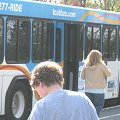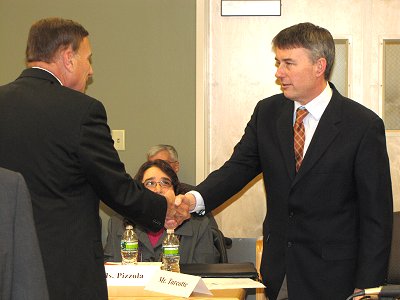- By Patty Poist
- News
 Print
Print  A predictable stream of federal funding to replace aging buses is critical to Tompkins Consolidated Area Transit, Inc.’s ability to serve a public and a local economy that is becoming more and more dependent on public transit, TCAT, Inc. General Manager Joe Turcotte told congressional leaders Thursday.
A predictable stream of federal funding to replace aging buses is critical to Tompkins Consolidated Area Transit, Inc.’s ability to serve a public and a local economy that is becoming more and more dependent on public transit, TCAT, Inc. General Manager Joe Turcotte told congressional leaders Thursday.Turcotte was one of 10 regional transportation industry experts that testified on Thursday, May 24, before a U.S. House Committee on Transportation & Infrastructure listening session in Cortland, N.Y., The listening session was headed by Committee Chairman U.S. Rep. John Mica, R‑Florida and hosted by U.S. Rep. Richard Hanna, R,C,I-Barneveld. Panelist included representatives from a variety of transportation industries, including paving contractors, engineers, a major bus manufacturer and truckers. The audience of about 50 people included elected officials, other regional transportation leaders and a representative from the United Auto Workers who said it “is in labor’s interest” to participate in the discussion as many workers in transportation industries are unionized.
Turcotte told the committee that though operational funding at around 12 percent has remained steady, but that there is no predictable structure for capital funding to replace older buses that are expensive to maintain. “It doesn’t make good economic sense to keep pumping money into an outdated bus,” Turcotte said.
He noted that TCAT has buses that are more than 20 years old, far surpassing their useful life of 12 years. TCAT, Inc. has been fortunate in the past to receive earmarks that “got us out of the hole.”
Indeed, earmarks, secured by U.S. Rep. Maurice Hinchey, D‑Hurley in the past has enabled TCAT to purchase new, fuel efficient and lower‑carbon‑producing buses as well as helped TCAT construct and upgrade much needed passenger amenities. Because earmarks are inherently arbitrary – and there is now a congressional moratorium on them – TCAT and other transit agencies are in a precarious position of figuring out ways to keep up with technology and replace buses and equipment.
“There is a lot of rust in New York,” he said. “We need a very predictable bus replacement funding mechanism so a lot of us can sleep at night,” Turcotte told the committee
TCAT last year, for the fourth year in a row, has broken ridership records. In 2010, annual ridership was nearly 3.6 million which “is a huge for a community this size.” TCAT is part of a regional study that could possibly lead to expanded service to serve out‑of‑county commuters who work in Tompkins County.
At a time when there is a strain on public coffers, TCAT and public transit agencies across the country are now being tasked with more requests for service, particularly as gas prices continue to increase. To be sure, TCAT’s ridership last month grew by 17.6 percent compared to February of last year due to escalating prices at the pump. That trend is taking place all across the United States, according to the American Public Transportation Association, which predicts that pain at the pump could translate into 1.5 billion additional passenger trips on U.S. public transportation systems.
Public reliance on public transit is “the highest it’s ever been,” said Turcotte, who has worked in larger public transit systems since 1993, first in Savannah, Ga., then in Charlotte, NC. before taking the job to head TCAT in 2005. In addition, bus replacement programs boost the economy by providing solid jobs for those who make their living in the bus manufacturing industry in New York, Turcotte said that, in turn, grows the economy and increases tax revenues.
 Joe Turcotte (right) is greeted by U.S. Rep. John Mica, R‑Florida before Thursday’s listening session.
Joe Turcotte (right) is greeted by U.S. Rep. John Mica, R‑Florida before Thursday’s listening session.Mica, who made brief comments on each participants' testimony, told panelists “don’t count on any increases” and that “the manna tree in Washington is dead.” Both Mica and Hanna, who is chairman of the subcommittee on highways, said their aim is to put into place a six‑year reauthorization plan to improve, streamline, and consolidate federal transportation programs “in order to develop the next, more effective surface transportation bill.”
In an interview afterward, Turcotte said he understands the need to for fiscal austerity, adding that TCAT is not asking for increases, but predictability. Investing in public transit is crucial to keep the economy as a whole on the path to recovery and federal investment is a positive net gain, he said.
Turcotte was echoed by Syracuse‑based CENTRO Executive Director Frank Kobliski, who is past president of the New York Public Transit Association. Kobliski was in the audience during the listening session and told the congressmen that he also understands the need for fiscal scrutiny.
“We get it – there are limitations to revenue available to support substantial growth in the reauthorization bill, said Kobliski, whose transit agency has a fleet in excess of 250 buses and an annual ridership of more than 15 million. However, Kobliski said, “transit agencies have tremendous challenges replacing and maintaining, in a state of good repair, their rolling stock and facilities.”
Among TCAT’s 55 buses, 16 are currently well past their 12‑year replacement mark. Of those, 15 this year will be swapped out for new buses that are being paid for by a combination of federal stimulus money, other federal grants, state money as well as contributions from TCAT’s three funding partners: Cornell University, Tompkins County and the City of Ithaca. Still, the fleet is aging rapidly. Another nine buses will reach their 12‑year useful life in 2013 and another nine buses will reach their retirement age in 2014.
Participating in the listening session was NYSDOT Commissioner Joan McDonald who talked about a number of transportation issues impacting New York, particularly its deteriorating infrastructure. She said New York is the most fuel efficient state in the country as a result of its transit systems “and we should not be penalized for that.”
Panelist Rich Ferguson, president and CEO of Daimler Buses North America, which has bus manufacturing plants in New York, told Mica and Hanna that his industry also needs consistency with federal funding. Federal stimulus money for transit agencies to pay for new buses caused a surge in activity and hiring, but after stimulus money dried up, business dropped off forcing painful layoffs. In addition, he noted, the bus manufacturing industry has been a leader in guiding energy policy that helps the nation cut down on its dependence on foreign oil by coming up with fuel alternatives.
Other panelists included Frances Pizzola, Founder & Community Education Coordinator, Access to Independence of Cortland County; Linda Shumaker, Shumaker Engineering, Joseph Compagni, President, Economy Paving Co., Inc.; F. Andrew Wolfe, Ph.D., P.E., Chair - Faculty of Engineering, Science, and Mathematics, SUNYIT; Robert Buerkle, Deputy Cortland County Highway Superintendent; William and Cyndi Klemm (independent truckers); and Frank H. Suits, Jr., President & CEO, Suit-Kote.
v7i13



